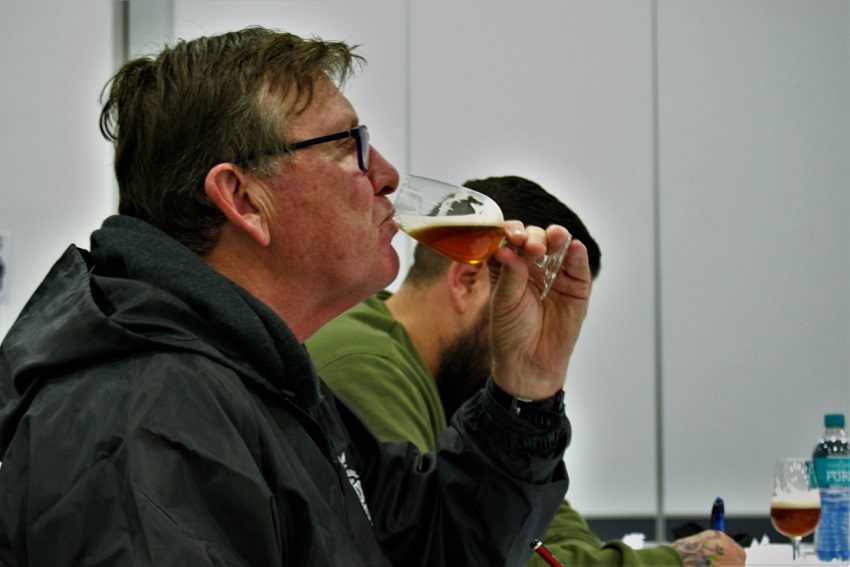Picking a winner at the Royal Adelaide Beer & Cider Awards

For Tony Jones, the process of judging a beer starts well before it passes his lips. Before he’s even smelled the beer he’s begun to score it on appearance, factoring in qualities like longevity of head, colour and clarity.
As the Head Judge at the Royal Adelaide Beer & Cider Awards, he needs to take these things seriously. Jones has plenty of experience — his previous roles have included Head Brewer of Southwark and Chief Brewer at Sydney’s Malt Shovel Brewery — but he’s not just going by personal taste. A thick style guide based on the American Brewers Association guidelines lists hundreds of styles of beers that can be entered. As well as technical qualities like alcohol content, there are detailed descriptions of the acceptable (and desirable) traits for every style.
After appearance, the judges rate each beer on aroma (“looking at the hop components in the aroma, the level of esters and also any defects, and then overall aroma complexity), flavour (“the intensity of the bitterness, the maltiness and body of the beer and again any off flavours”), technical faults in production and correctness to style. These scores are combined to give a total out of 20, with 17 and above being a gold medal standard, 15.5 netting a silver and 14 a bronze.
That means there’s not a lot of room for error, and it’s important for brewers to nail the brief. Categories like lager and Australian pale ale tend to be similar in flavour profile and reward adherence to tradition. At the other end of the spectrum, the “other” and “hybrid” categories are filled with all manner of wild and wonderful beers that are more focussed on creativity than tradition.
Unsurprisingly, these more experimental endeavours usually come from the craft breweries that have helped to drive a huge increase in entries over the last few years (including New Zealand first beer entry this year).
To keep those beers coming out smoothly, a team of stewards works just out of sight, beyond a line of wall panels. Judges are strictly prohibited from this area so that the tastings are blind, but a quick look reveals the scale of the job. Nine pallets of beer cartons are lined up on one side of the preparation area. More pallets holding kegs are hidden behind a mobile bar and fridges are filled with bottles and cans in all manner of shapes, sizes and colours.

Each of these receptacles has a small sticker with the number that determines what order they’ll be tasted in, and wine glasses that have been washed with hot water (no soap) are lined up in readiness. Once these are filled with brews of pale straw, deep amber or jet black, a steward checks the temperature (most beers are served at 8˚ unless there’s a special brewers note), and they’re ready to be tasted.
It’s an efficient system, and the stewards go about their business surprisingly quietly. So quietly, in fact, that every now and again it’s possible to hear the sound of glasses clinking from beyond the panels, which indicates that the judges have awarded another gold.
With 240 beers to taste, the duties are split between two panels, each of which sits for two days (cider needs a single panel for just a day). After a calibration beer to ensure that everyone is on the same page, they work through the beers in order of classes, from low alcohol to high and leaving the most flavoursome styles until last so as to preserve their palates. Because the tastings are blind, all they have is a style and the brewer’s notes, and after each judge has determined a score out of twenty and noted down their impressions, the scores of the entire panel are averaged.
A discussion may follow if there are outliers or if a beer is sitting right on the edge of a medal category, and occasionally a score will be slightly changed or even retracted based on this to give what everyone agrees is a fair score.

The panel members are brewers or brewery employees who work on the technical side of production, and all of them have some training in sensory evaluation. That means sometimes they’ll recognise an entrant as their own product, in which case they’ll proceed as normal until the scores are read out, then announce the conflict of interest and retract their score from the calculations. But even with these highly trained experts, there’s always a chance they’ve misidentified something — it’s why they sit on panels rather than judging individually.
“We had a panel member today who asked for her score to be excused because it was one of her products,” Jones explains. “I said ‘well I’ve got the information sheet here and that’s not yours because it’s got a different alcohol content’… Particularly in some of the lighter styles there can be beers that are quite similar in flavour profile”
The slight uncertainty, and the difference between batches of the same beer helps to keep the judges on their toes and keeps things interesting for Jones.
“When the results are announced, there are often a few surprises. As the chief judge, I try to not look at the entries at all so from a broad perspective I’ve got no idea until the results come out who actually won.”
The winners of the Royal Adelaide Beer & Cider Awards are announced on Friday, July 6 at the Beer & BBQ Festival at Wayville Showgrounds.